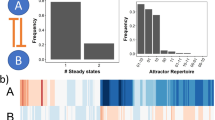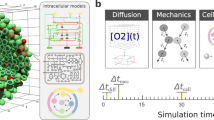Abstract
To elucidate the hidden dynamics of extracellular-signal-regulated kinase (ERK) signalling networks, we developed a simulation model of ERK signalling networks by constraining in silico dynamics based on in vivo dynamics in PC12 cells. We predicted and validated that transient ERK activation depends on rapid increases of epidermal growth factor and nerve growth factor (NGF) but not on their final concentrations, whereas sustained ERK activation depends on the final concentration of NGF but not on the temporal rate of increase. These ERK dynamics depend on Ras and Rap1 dynamics, the inactivation processes of which are growth-factor-dependent and -independent, respectively. Therefore, the Ras and Rap1 systems capture the temporal rate and concentration of growth factors, and encode these distinct physical properties into transient and sustained ERK activation, respectively.
This is a preview of subscription content, access via your institution
Access options
Subscribe to this journal
Receive 12 print issues and online access
$209.00 per year
only $17.42 per issue
Buy this article
- Purchase on Springer Link
- Instant access to full article PDF
Prices may be subject to local taxes which are calculated during checkout








Similar content being viewed by others
References
Vaudry, D., Stork, P.J., Lazarovici, P. & Eiden, L.E. Signaling pathways for PC12 cell differentiation: making the right connections. Science 296, 1648–1649 (2002).
Gotoh, Y. et al. Microtubule-associated-protein (MAP) kinase activated by nerve growth factor and epidermal growth factor in PC12 cells. Identity with the mitogen-activated MAP kinase of fibroblastic cells. Eur. J. Biochem. 193, 661–669 (1990).
Qiu, M.S. & Green, S.H. PC12 cell neuronal differentiation is associated with prolonged p21ras activity and consequent prolonged ERK activity. Neuron 9, 705–717 (1992).
Traverse, S., Gomez, N., Paterson, H., Marshall, C. & Cohen, P. Sustained activation of the mitogen-activated protein (MAP) kinase cascade may be required for differentiation of PC12 cells. Comparison of the effects of nerve growth factor and epidermal growth factor. Biochem. J. 288, 351–355 (1992).
Egan, S.E. et al. Association of Sos Ras exchange protein with Grb2 is implicated in tyrosine kinase signal transduction and transformation. Nature 363, 45–51 (1993).
Rozakis-Adcock, M., Fernley, R., Wade, J., Pawson, T. & Bowtell, D. The SH2 and SH3 domains of mammalian Grb2 couple the EGF receptor to the Ras activator mSos1. Nature 363, 83–85 (1993).
Li, N. et al. Guanine-nucleotide-releasing factor hSos1 binds to Grb2 and links receptor tyrosine kinases to Ras signalling. Nature 363, 85–88 (1993).
Gale, N.W., Kaplan, S., Lowenstein, E.J., Schlessinger, J. & Bar-Sagi, D. Grb2 mediates the EGF-dependent activation of guanine nucleotide exchange on Ras. Nature 363, 88–92 (1993).
Davis, R.J. The mitogen-activated protein kinase signal transduction pathway. J. Biol. Chem. 268, 14553–14556 (1993).
Di Fiore, P.P. & Gill, G.N. Endocytosis and mitogenic signaling. Curr. Opin. Cell. Biol. 11, 483–488 (1999).
Waterman, H. & Yarden, Y. Molecular mechanisms underlying endocytosis and sorting of ErbB receptor tyrosine kinases. FEBS Lett. 490, 142–152 (2001).
Soler, C., Beguinot, L., Sorkin, A. & Carpenter, G. Tyrosine phosphorylation of ras GTPase-activating protein does not require association with the epidermal growth factor receptor. J. Biol. Chem. 268, 22010–22019 (1993).
Jones, N. & Dumont, D.J. Recruitment of Dok-R to the EGF receptor through its PTB domain is required for attenuation of Erk MAP kinase activation. Curr. Biol. 9, 1057–1060 (1999).
Waters, S.B. et al. Desensitization of Ras activation by a feedback disassociation of the SOS-Grb2 complex. J. Biol. Chem. 270, 20883–20886 (1995).
Dong, C., Waters, S.B., Holt, K. & Pessin, J.E. SOS phosphorylation and disassociation of the Grb2–SOS complex by the ERK and JNK signaling pathways. J. Biol. Chem. 271, 6328–6332 (1996).
Marshall, C.J. Signal transduction. Taking the Rap. Nature 392, 553–554 (1998).
York, R.D. et al. Rap1 mediates sustained MAP kinase activation induced by nerve growth factor. Nature 392, 622–666 (1998).
Kao, S., Jaiswal, R.K., Kolch, W. & Landreth, G.E. Identification of the mechanisms regulating the differential activation of the MAPK cascade by epidermal growth factor and nerve growth factor in PC12 cells. J. Biol. Chem. 276, 18169–18177 (2001).
Wu, C., Lai, C.F. & Mobley, W.C. Nerve growth factor activates persistent Rap1 signaling in endosomes. J. Neurosci. 21, 5406–5416 (2001).
Chang, J.H., Mellon, E., Schanen, N.C. & Twiss, J.L. Persistent TrkA activity is necessary to maintain transcription in neuronally differentiated PC12 cells. J. Biol. Chem. 278, 42877–42885 (2003).
Ohtsuka, T., Shimizu, K., Yamamori, B., Kuroda, S. & Takai, Y. Activation of brain B-Raf protein kinase by Rap1B small GTP-binding protein. J. Biol. Chem. 271, 1258–1261 (1996).
Vossler, M.R. et al. cAMP activates MAP kinase and Elk-1 through a B-Raf- and Rap1-dependent pathway. Cell 89, 73–82 (1997).
Bhalla, U.S. & Iyengar, R. Emergent properties of networks of biological signaling pathways. Science 283, 381–387 (1999).
Schoeberl, B., Eichler-Jonsson, C., Gilles, E.D. & Muller, G. Computational modeling of the dynamics of the MAP kinase cascade activated by surface and internalized EGF receptors. Nature Biotechnol. 20, 370–375 (2002).
Brightman, F.A. & Fell, D.A. Differential feedback regulation of the MAPK cascade underlies the quantitative differences in EGF and NGF signalling in PC12 cells. FEBS Lett. 482, 169–174 (2000).
Shvartsman, S.Y. et al. Autocrine loops with positive feedback enable context-dependent cell signaling. Am. J. Physiol. Cell. Physiol. 282, C545–C559 (2002).
Bhalla, U.S., Ram, P.T. & Iyengar, R. MAP kinase phosphatase as a locus of flexibility in a mitogen-activated protein kinase signaling network. Science 297, 1018–1023 (2002).
Hatakeyama, M. et al. A computational model on the modulation of mitogen-activated protein kinase (MAPK) and Akt pathways in heregulin-induced ErbB signalling. Biochem. J. 373, 451–463 (2003).
Yamada, S., Taketomi, T. & Yoshimura, A. Model analysis of difference between EGF pathway and FGF pathway. Biochem. Biophys. Res. Commun. 314, 1113–1120 (2004).
Kholodenko, B.N., Demin, O.V., Moehren, G. & Hoek, J.B. Quantification of short term signaling by the epidermal growth factor receptor. J. Biol. Chem. 274, 30169–30181 (1999).
Downward, J. The GRB2/Sem-5 adaptor protein. FEBS Lett. 338, 113–117 (1994).
Langlois, W.J., Sasaoka, T., Saltiel, A.R. & Olefsky, J.M. Negative feedback regulation and desensitization of insulin- and epidermal growth factor-stimulated p21ras activation. J. Biol. Chem. 270, 25320–25323 (1995).
Holt, K.H. et al. Epidermal growth factor receptor targeting prevents uncoupling of the Grb2-SOS complex. J. Biol. Chem. 271, 8300–8306 (1996).
Nishida, E. & Gotoh, Y. The MAP kinase cascade is essential for diverse signal transduction pathways. Trends Biochem. Sci. 18, 128–131 (1993).
Bourne, H.R., Sanders, D.A. & McCormick, F. The GTPase superfamily: conserved structure and molecular mechanism. Nature 349, 117–127 (1991).
Choi, D.Y., Toledo-Aral, J.J., Segal, R. & Halegoua, S. Sustained signaling by phospholipase C-gamma mediates nerve growth factor-triggered gene expression. Mol. Cell. Biol. 21, 2695–2705 (2001).
Longva, K.E. et al. Ubiquitination and proteasomal activity is required for transport of the EGF receptor to inner membranes of multivesicular bodies. J. Cell Biol. 156, 843–854 (2002).
Moghal, N. & Sternberg, P.W. Multiple positive and negative regulators of signaling by the EGF-receptor. Curr. Opin. Cell Biol. 11, 190–196 (1999).
Arevalo, J.C., Yano, H., Teng, K.K. & Chao, M.V. A unique pathway for sustained neurotrophin signaling through an ankyrin-rich membrane-spanning protein. EMBO J. 23, 2358–2368 (2004).
de Rooij, J. & Bos, J.L. Minimal Ras-binding domain of Raf1 can be used as an activation-specific probe for Ras. Oncogene 14, 623–625 (1997).
Acknowledgements
We thank K. Kaibuchi, Y. Gotoh, M. Kawato and M. Arita for critically reading this manuscript, and R. Kettunen and R. Kunihiro for their technical assistance. This work was supported in part by a grant in-aid for scientific research from the Ministry of Education, Culture, Sports, Science and Technology of Japan, and by a grant in-aid from Uehara Memorial Foundation.
Author information
Authors and Affiliations
Corresponding author
Ethics declarations
Competing interests
The authors declare no competing financial interests.
Supplementary information
Supplementary Information S1
Supplementary Figures S1, S2, S3, S4 and S5 (PDF 726 kb)
Supplementary Information S2
Supplementary Table S1 (PDF 66 kb)
Rights and permissions
About this article
Cite this article
Sasagawa, S., Ozaki, Yi., Fujita, K. et al. Prediction and validation of the distinct dynamics of transient and sustained ERK activation. Nat Cell Biol 7, 365–373 (2005). https://doi.org/10.1038/ncb1233
Received:
Accepted:
Published:
Issue Date:
DOI: https://doi.org/10.1038/ncb1233
This article is cited by
-
High-throughput and proteome-wide discovery of endogenous biomolecular condensates
Nature Chemistry (2024)
-
Stochastic model of ERK-mediated progesterone receptor translocation, clustering and transcriptional activity
Scientific Reports (2022)
-
A multi-layered hybrid model for cancer cell invasion
Medical & Biological Engineering & Computing (2022)
-
Application of information theory in systems biology
Biophysical Reviews (2020)
-
Mathematical model of hypoxia and tumor signaling interplay reveals the importance of hypoxia and cell-to-cell variability in tumor growth inhibition
BMC Bioinformatics (2019)



